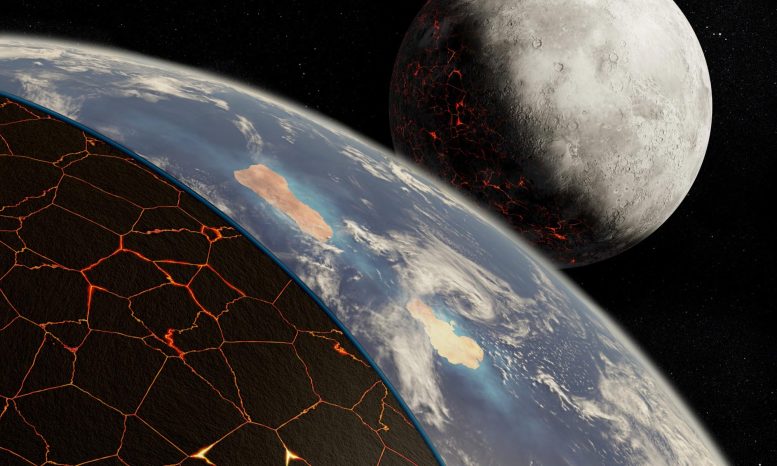
Plate tectonics involves the horizontal movement and interaction of large plates on Earth’s surface. New research indicates that mobile plate tectonics—thought to be necessary for the creation of a habitable planet—was not occurring on Earth 3.9 billion years ago. Credit: University of Rochester illustration / Michael Osadciw
A multi-institution team found evidence that the Earth’s magnetic field was stable 3.9 to 3.4 billion years ago when life is thought to have emerged, suggesting that continents were fixed rather than experiencing plate tectonics, thereby challenging the belief that mobile plate tectonics is essential for life’s origination.
A Florida State University (FSU) faculty member’s research is helping to uncover more about the conditions necessary for the beginnings of life on Earth.
FSU Assistant Professor Richard Bono was part of a multi-institution team that found evidence that the planet’s magnetic field was stable from 3.9 to 3.4 billion years ago, a time when scientists think life may have first originated. Their research was published in the journal Nature.
Bono explained more about what the team found and its implications for the origins of plate tectonics and life on Earth.

Florida State University Assistant Professor Richard Bono. Credit: Florida State University
What did the research team find?
Our research showed that Earth’s magnetic field was stable from 3.9 to 3.4 billion years ago, which corresponds with the oldest known fossils. Unlike earlier research, which took data from a single site, we measured magnetic carriers found in the mineral zircon from two separate ancient continental masses. The findings suggest that the magnetic field was stable and nearly identical for over half a billion years. This unvarying field could be explained by continents that were fixed in place, but for most of Earth’s history, the rocky plates that make up the continents were in constant motion on the surface of the planet — a phenomenon called plate tectonics. This finding helps us pinpoint when mobile plate tectonics may have started.
Why is this important?
Plate tectonics are thought to be one of the fundamental factors in existence of life on Earth. The present-day configuration of continents and oceans, as well as supercontinents like Pangea, is because of plate tectonics. Through the creation and destruction of rocky crust, plate tectonics are thought to control the cycling of elements necessary for life. However, the timing of when mobile plate tectonics started is unknown. If life on Earth originated about 3.8 billion years ago, it would have been during this stagnant regime. This finding suggests that modern mobile plate tectonics are not a requirement for the origin of life, expanding our understanding of what makes a planet habitable.
How did this study expand on our existing understanding of the Earth?
Previous research documented evidence for the presence of a magnetic field coming from the Earth’s core as early as 4.2 billion years ago. But that data just came from Australia. Because it was from a single continent, we couldn’t use it to detect plate motion. This study adds new data from a different continent, allowing us to investigate relative variations in field strength from the different locations, which could help infer possible plate motion.
How did you complete the research?
We analyzed rock samples collected during field expeditions to Australia and South Africa for individual zircon grains less than a millimeter in size. We measured the strength of the sample’s magnetization in a magnetically shielded laboratory at the University of Rochester by heating the sample grain with a laser and measuring how the magnetization changed with an ultra-high sensitivity magnetometer. We also measured the ages of each zircon grain at the Geological Survey of Canada using a superhigh-resolution ion microprobe.
With that new data, we could perform new statistical analyses and compare those with existing plate motion models. We found that what we saw in our new data set could not be explained by normal variation of the plate tectonic processes at work for at least the last 600 million years.
Who else was part of this research?
This study was a multi-institution endeavor led by University of Rochester Professor John Tarduno, with other co-authors from the Geological Survey of Canada, University of California Santa Cruz, University of Johannesburg, University of the Witwatersrand, University of Arizona, University of KwaZulu-Natal and Geological Survey of Japan. The research was supported by the National Science Foundation.
For more on this research, see Life Sprung From a “Stagnant Lid,” Not Plate Tectonics.
Reference: “Hadaean to Palaeoarchaean stagnant-lid tectonics revealed by zircon magnetism” by John A. Tarduno, Rory D. Cottrell, Richard K. Bono, Nicole Rayner, William J. Davis, Tinghong Zhou, Francis Nimmo, Axel Hofmann, Jaganmoy Jodder, Mauricio Ibañez-Mejia, Michael K. Watkeys, Hirokuni Oda and Gautam Mitra, 14 June 2023, Nature.
DOI: 10.1038/s41586-023-06024-5








Existing theories of life’s emergence…
“thereby challenging the belief that mobile plate tectonics is essential for life’s origination.”
“Plate tectonics are thought to be one of the fundamental factors in existence of life on Earth.”
Where are published reference to support these statements?
The article relates one of several current hypotheses.
It is interesting if it can be shown wrong.
And absence of continental crust and hence sediments can explain why earlier fossils are absent. That would better correlate with phylogenetic evidence that consistently (albeit by construction) wants to push the tree of life root as early as we have evidence of a global ocean (at ~4.3 billion years ago).
More evidence for the timing: ““Our oldest samples show no sign of surficial material recycling at 4.0 [billion years ago],” said IGGCAS’s Professor Li Xianhua in a statement. “And the earliest evidence we find for surface recycling into magmas isn’t until 3.8 [billion years ago].”
The conclusions are based on silicon and oxygen isotopes in the rocks. The early oceans were rich in heavy silicon. In the absence of life, this sank to the seafloor. Yet the rocks Mitchell and Li tested are not enriched with heavy isotopes as would be expected if the silicon was being recycled through magma chambers to be spewed out by volcanoes.”
[“Plate Tectonics May Be Younger Than Life, Earth’s Oldest Rocks Suggest”, Stephen Luntz, IFLScience, July 6, 2023]
Typo: An absence.